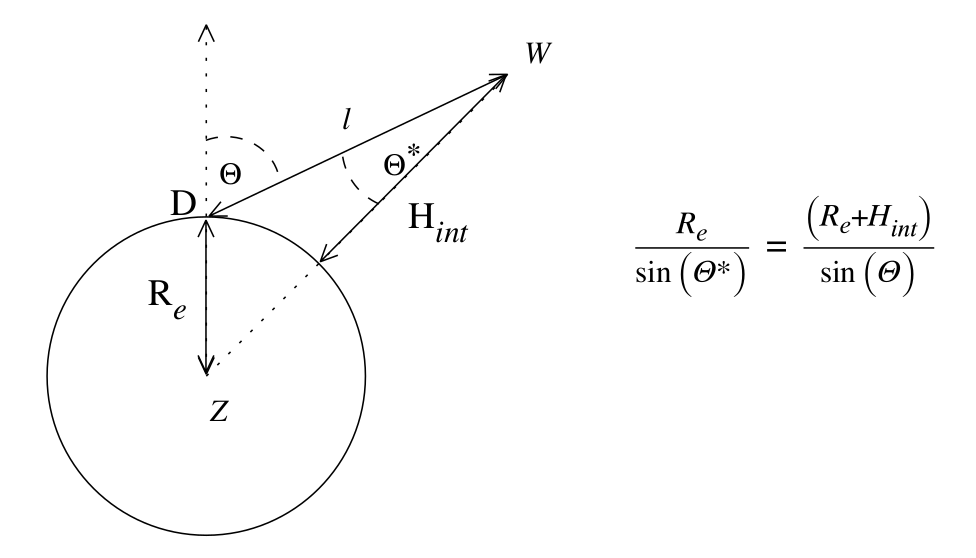Overview¶
The analysis at hand aims on retrieving information about the abundance of atmospheric muons in the South Pole ice and at the ice surface. The majority of events detected in IceCube’s in-ice array is caused by atmospheric muons produced in cosmic ray induced air showers in the upper layers of the atmosphere. Upon entering the antarctic ice, they lose significant amounts of their energy in interactions with the surrounding matter, resulting in a limitation of their propagation length. The analysis is based on a sub-set of events, comprising mostly single muons that stop inside the IceCube detector. This means the particles do not traverse the entire detector, which enables the determination of their stopping point within the instrumented volume. In case of a muon bundle entering the detector, IceCube can not resolve the individual particles. This leads to the fact that only the stopping point of the highest energetic (leading) muon can be measured. However, the lower energetic muons are expected to stop before entering the detector for most of the stopping events, which results in a single muon being observed. Further details follow in the event selection section.
The muon’s propagation length can be determined from its vertical stopping depth and zenith angle. Measuring this quantity allows to unfold the stopping muon depth intensity, which refers to the number of muons stopping at certain length. It also serves as a proxy for the surface energy because high-energy muons can propagate much further through the ice.
The main goals of the analysis are the determination of the
Stopping muon depth intensity
Muon surface energy spectrum
with one year (2020) of IceCube data. The results are compared to theoretical expectations and earlier findings of other experiments. They can be used to fit the spectral index \(\gamma\) and effective energy loss parameters \(a\) and \(b\) for the South Pole ice (\(\frac{\mathrm{d}E}{\mathrm{d}x} = a + b \cdot E\)). It is further planned to unfold data from only certain parts of the detector and from different zenith bands as systematic checks.
The vertical muon depth intensity relation \(I(L)\) has been determined by a variety of underground experiments (see Fig. 2) and follows the parametrization
where \(A\), \(L_{0}\) and \(\alpha\) are open parameters. The depth intensity is expected to follow an angular dependence of the form
It is thus converted to the vertical intensity by multiplying with the factor \(\cos{\Theta^{*}}\), where \(\Theta^{*}\) denotes the atmospheric zenith angle. The atmospheric zenith differs from the zenith angle on the Earth’s surface, as shown in Fig. 1.

Fig. 1 : Calculation of the atmospheric zenith angle \(\Theta^{*}\) from the zenith angle on the Earth’s surface. The parameter \(H_{\mathrm{int}}\) denotes the average interaction height of protons in the atmosphere. (Image source: W. Rhode: “Untersuchung der Energiespektren hochenergetischer Muonen im Fréjusdetektor”, 1993)¶
Fig. 2 : Vertical muon depth intensity relation measured with the LVD, MACRO, Fréjus and NUSEX¶
The differential stopping muon depth intensity is the derivative of this function:
The muon depth intensity \(I(L)\) counts all muons at a certain propagation length (including muons that are propagating even further), whereas the stopping muon depth intensity \(\frac{\mathrm{d}I}{\mathrm{d}L}\) only counts the muons that are stopping at a certain length.
The stopping muon depth intensity relation is to be verified using IceCube data. To this end, a set of stopping muon events has to be selected from in-ice measurements. The reconstruction of the muon’s stopping point and direction provides the information needed to determine the flux of particles with a certain propagation length. The length is calculated assuming a flat surface via
where \(z_{\mathrm{stop}}\) is the vertical stopping depth and \(\Theta\) the zenith angle of an event.
Using the propagation length as a proxy for particle energy, it is further possible unfold the surface energy spectrum of atmospheric muons in the low energy regime. The analysis aims on determining the energy spectrum between a few hundred GeV and \(10\) TeV.
The necessary classification and reconstruction tasks to select a stopping muon sample from measurements are performed using a deep neural network. More information about the event selection is provided in the following sections.